Got pests? Hate chemicals? Would you like to deploy an army of garden good guys to fight the bad bugs? There are many plants that are known for luring good bugs to your garden. Here in Florida, we have a few unique problems and predators that you won’t find in most other states. Let’s look at some ways to encourage the right insect neighbors.
First, what are beneficial insects? They are insects that help in the garden by pollinating plants or preying on the bad bugs. A few are familiar – most gardeners try to encourage bees for pollinating, as well as ladybugs, which eat aphids. There are also a variety of lesser-known heroes such as hoverflies, which are striped like bees and eat aphids and thrips, and parasitic wasps, tiny, non-stinging wasps that lay eggs on tomato hornworms and other damaging caterpillars. Sometimes, the scary-looking bugs are heroes in disguise, such as minute pirate bugs and big-eyed bugs, which gorge on smaller insects like mites and thrips. And some good guys can’t even be seen without a magnifying lens, such as swirksi mites, which energetically run around the leaves searching for chili thrips to eat.
So now that we know there are troops ready to help, how do we invite them to battle in our garden? They need what all soldiers need – food. That’s what the bad bugs are for, right? Sure, having a buffet of aphids may attract some predators, but a bad infestation will be hard for even the hungriest ladybug to finish off. It’s best to attract the beneficials first, so when a few aphids drop by, they are quickly turned into brunch. So what other delicacies may attract our heroes?

Turns out, most beneficial insects eat pollen or nectar at some point in their lifecycle. Adult hoverflies, for example, feed on nectar, while their larvae eat aphids. So planting a variety of pollen and nectar-producing flowers will be an open invitation to these useful allies. Plants of different heights and bloom times will attract the widest variety of helpers. Here are some of the best insectary plants for a Central Florida garden:
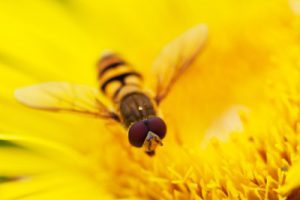
Herbs – Dill, parsley, fennel, and cilantro are all cool-season plants that provide both fresh herbs, and, once they bloom, attract ladybugs and parasitic wasps. Thyme, mint, basil, and rosemary also attract different beneficials throughout the year. African blue basil makes a large flowery shrub that is usually covered in bees.

Sunflowers attract many pollen-loving insects including hoverflies and minute pirate bugs. Be sure to check the variety; some of the newer dwarf or cut flower varieties don’t produce pollen – good for bouquets, but not great for feeding beneficials.
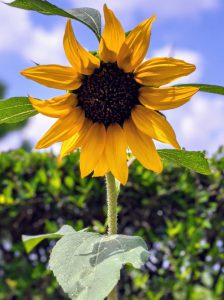
Some common bedding plants are fantastic attractors, such as marigolds, zinnias, and sweet alyssum. Alyssum is such a powerhouse that it is sometimes interplanted with lettuce and other crops in organic fields, happily growing in any gaps. If buying transplants, make sure they have not been treated with insecticides.

Many Florida native flowers are adapted to attract beneficials for their own protection. Coreopsis, beach sunflower, gaillardia, and coneflower all provide large, flat landing pads for pollinators. Dotted horsemint, our native beebalm, is a bee favorite. And some great native landscape shrubs such as Walter’s viburnum, yaupon holly, saw palmetto, and gallberry, provide loads of pollen.
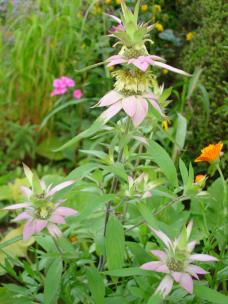
There are also many non-flowering plants that attract beneficials. Some have nectar glands along their stems, such as passionflower and elderberry. And clumping grasses provide cover for beetles and other insects.
Some plants offer a more subtle way of ensuring beneficals are fed. Called “banker plants,” they attract a non-pest prey species, which in turn attracts beneficials. Essentially, they are a food bank for the good guys. An example is papaya, which attracts a particular whitefly that only feeds on papaya. But since whitefly predators will eat any kind of whitefly, it lures a ready defense force to your garden. Other banker plants are milkweed, which attracts oleander aphids and thus aphid-eating insects, and thai pepper, which is a home base for swirski mites.
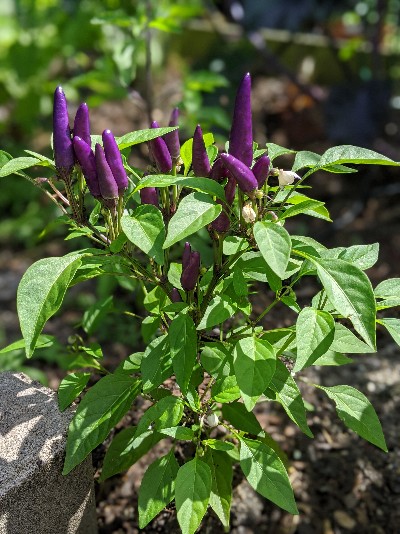
When inviting beneficials, be generous in planting. One little thai pepper won’t host enough good guys to protect a dozen rose bushes. Mix the insectary flowers liberally through your landscape or vegetable garden. And remember, pesticides don’t know the difference between good bugs and bad ones, so don’t spray! You don’t want to invite beneficials in just to lure them to their deaths.
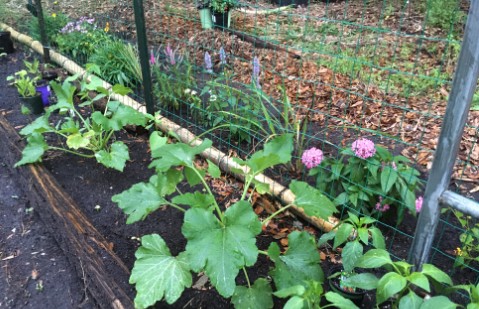
For more information on beneficial insects and insectary plants, check out this presentation: http://discover.pbcgov.org/coextension/horticulture/pdf/nursery/BeneficialInsectsTreasureCoastRareFruitVegetableCouncilTalk8-16-2012.pdf. Insectary plants are an effective, economical, and earth-friendly way to protect your landscape. They are especially useful in vegetable gardens, where they call in protectors for your tender peppers and lettuce. Plus, the flowers add to the beauty of your plant beds. With so many benefits, why not plant some today?
There is also a guide on Beneficial Insect Habitat from the Xerces Society. http://xerces.org/sites/default/files/2018-05/15-022_01_XercesSoc_HabitatAssessGuide_Beneficial-Insects_Farms%2BAg_web.pdf
This blog post was written by UF/IFAS Extension Orange County Master Gardener Volunteer Mary Ann Pigora, class of 2017. The UF/IFAS Extension Orange County Master Gardener Volunteers play a crucial role in the outreach of UF/IFAS Extension.
Want to learn more? Check out horticulture classes offered by UF/IFAS Extension Orange County at www.ocextension.eventbrite.com. Read about Florida-Friendly Landscaping™ at https://ffl.ifas.ufl.edu/. Follow us on Facebook at https://www.facebook.com/GardenFlorida/ and Instagram at https://www.instagram.com/oc_extension/or call 407-254-9200.
 8
8
